Kamchatka - federal subject of Russia
Kamchatka (Russian: Камча́тка) is a 1,250-km-long 270,000 km<sup>2</sup> peninsula in the Russian Far East, protruding into the northern Pacific Ocean. Kamchatka Krai is a county which also includes parts of the Russian mainland, and some small islands. Though larger than California, the krai has only about 315 000 inhabitants (2018); most of them in or near the capital, Petropavlovsk-Kamchatsky. The region borders Chukotka in the north and northeast and Magadan Oblast in the northwest.
Kamchatka is extremely geologically active and has numerous volcanoes, geysers, hot springs, and even a lake of acid! It contains the southernmost expanse of Arctic tundra in the world and is notable for its wealth of Arctic wildlife, fish, game, and marine life. Furthermore, 19 of Kamchatka's volcanoes constitute the "Volcanoes of Kamchatka" UNESCO World Heritage Site.
Cities

- Petropavlovsk-Kamchatsky - the only sizable city in Kamchatka and home to over half the peninsula's population.
- Yelizovo - hosts the Petropavlovsk-Kamchatsky airport, the only commercial airport on the peninsula.
- Palana - capital of the northern Koryakia region of Kamchatka.
- Paratunka 📍 - balneological kurort (bath/hot spring resort).
- Esso - center for dog-sled racing.
- Anavgai 📍 - nomadic camp of Evens.
Other destinations
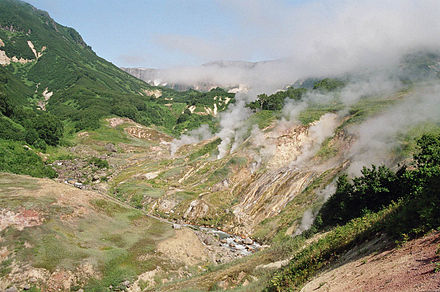
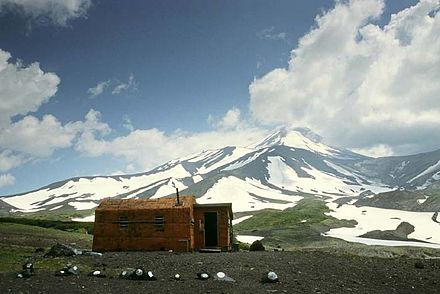
- The stunning and enormous Kronotsky Nature Reserve — accessible only via helicopter, and home to the Kronotsky Volcano as well as the Valley of the Geysers.
- The Valley of the Geysers — perhaps the most well known part of the UNESCO World Heritage site, is located within the mammoth Kronotsky Nature Reserve and was the second largest geyser field in the world (and the only in Eurasia) with 90 geysers and numerous hot springs in a 6 km-long valley. Sadly it was mostly destroyed by a massive freak mudslide in 2007 that covered two thirds of the field.
- The Komandorsky Nature Reserve (dead link: December 2020)
- Nalychevo Nature Park
- Southern Kamchatka Nature Park 📍 (Yuzhno-Kamchatsky Zakaznik)
- Bystrinsky Nature Park
- Kluchevskoy Nature Park
- Blue Lakes Nature Park (Golubye Ozyora)
- Koryaksky Zapovednik (dead link: December 2020) — beautiful and almost impossibly remote, this reserve offers bear-watching opportunities galore.
Understand
Kamchatska is a unique land where fire meets ice. It contains the southernmost expanse of Arctic tundra as well as 160 volcanoes (29 of them active). Despite its great size the peninsula is home to just 315,000 people (2018), half of which live in Petropavlovsk-Kamchatsky and another 50-100,000 live in nearby communities (including Yelizovo). As such, the peninsula is vastly uninhabited wilderness where one can climb volcanoes, sport hunt for bears, visit geysers, spend hours in natural hot springs, or go fishing in wild rivers or off the coast. Politically, it is divided between Kamchatka Krai and Koryak Okrug (Koryakia).
History
Kamchatka, like much of Arctic Siberia and North America, was originally sparsely inhabited by native tribes. In the 16th century, spurred by tales of a land of fire that was rich in fish and furs, Kamchatka was claimed by Muscovite Russia. Two settlements were built by Cossacks in 1697 as fur trading posts.
The peninsula was mapped during Vitus Bering's expedition to explore the Russian Far East and reach North America. In 1740 Bering reached Avacha Bay and laid the cornerstone for the settlement of Petropavlovsk, named after his two ships St. Peter and St. Paul. One year later, Petropavlovsk would be the settlement survivors of another one of Bering's expeditions would reach with the news of his death and the discovery of Alaska. They would also bring artifacts, including sea otter pelts, considered the "finest fur in the world", from Alaska which would eventually motivate Russia's interest in North America. Petropavlovsk grew into a main stopping point for travelers on the way to the Russian Far East, the Kuril Islands, and North America.
In 1854 during the Crimean War, a joint Anglo-French naval fleet bombarded Petropavlovsk in what became known as the heroic defense of the city in which 988 men with just 68 guns defended it against 6 ships with 206 cannons and 2,540 French and British troops. The Russians realized the city was a liability and when more invaders came a year later the city was abandoned and burnt to the ground. With the sale of the Kuril Islands to Japan and Alaska to the US, the peninsula waned in importance. Following World War II Kamchatka was deemed a military zone and was placed off limits to Russians (excluding residents) until 1989 and to foreigners until 1991.
The peninsula hosts the largest Russian nuclear submarine pen and submarine construction yard. A major event during the Cold War in the early 1980s was the intentional shooting down by the Soviet Union of a Korean Air (Flight 007) civilian airliner that inadvertently drifted off course when flying over an extremely sensitive military area in Kamchatka.
Climate
Kamchatka's climate is diverse and encompasses several climate zones divided along alpine, coastal and geothermal lines. The most popular time for tourists to visit is during the summer and autumn months, when max temperatures range from 15 °C (59 °F) to 30 °C (86 °F) (in the winter the average temperature is -25 °C (-13 °F)). The high season lasts from June to September. The weather is marine and therefore changeable. In the summer temperatures can fall significantly at night; rain and humidity brought by the Sea of Okhotsk and the Pacific Ocean are not uncommon, and rainfall can add up at 1000 mm per year. Mosquitoes are active until September and may cause some discomfort, but only appear in low altitudes. Swimming in the Avacha Bay is a popular activity in the summer months.
Get in
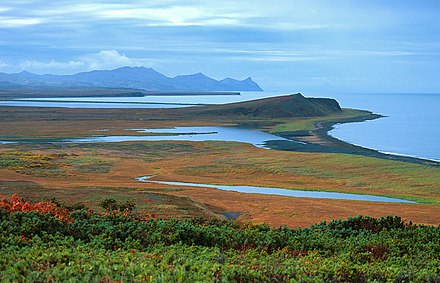
By car
There are no roads connecting Kamchatka with other parts of Russia. Indeed, Petropavlovsk-Kamchatsk is the second-largest mainland city in the world which cannot be reached by road (the largest being Iquitos).
By plane
Arriving by plane is the only practical way of reaching Kamchatka. All commercial flights arrive at Yelizovo, only 16 km from Petropavlovsk-Kamchatsky IATA: PKC (which airlines list as the destination). There are regular flights between Petropavovsk-Kamchatsky and Moscow (Aeroflot, Transaero), Saint Petersburg (Rossiya), Novosibirsk (S7, Rossiya), Irkutsk (S7), Khabarovsk (S7, SAT Airlines), and Vladivostok (S7, Aeroflot). Yakutia flies an Antonov 24 to Magadan and on to Yakutsk weekly or every two weeks (seasonal) on Wednesdays. Yakutia Air has seasonal service between Anchorage, Alaska, and Petropavlovsk-Kamchatsky. They also offer seasonal flights from Tokyo. Korean Airlines offers frequent charter flights from Incheon in the summer.
By boat
It may be possible to hitch a ride on boats from the Kuril Islands,
Get around
By car
Depending on your destination there are Russian and Japanese jeeps as well as 6WD Ural and Kamaz trucks with a booth for passengers as 4WD tend to be incapable of handling the majority of dirt roads, especially in snow.
The bus stations that have routes around the region are located in both Yelizovo and Petropavlovsk-Kamchatsky.
By air
Kamchatka Aviation Enterprise (dead link: December 2020) serves numerous destinations on the peninsula:
- Nikolskoe (Kommandorsky islands):once a week;
- Ozyornaya: 1–3 times a week;
- Ossora: 1–2 times a week;
- Palana: 5 times a week;
- Sobolevo: once a week;
- Tigil: once a week;
- Tilichiki: 3 times a week;
- Ust'-Kamchatsk: once a week and Khairyuz: once a week.
Vityaz Aero offers helicopter charters.
By dogsled
Dogsleds are used instead of taxis in Esso.
See

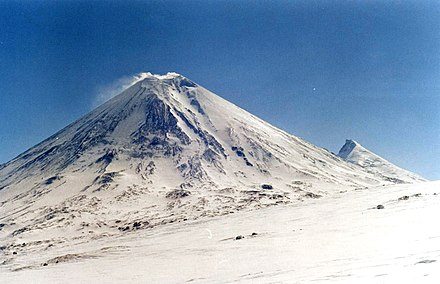 There are many places to sight see. The bravest tourists can trek for months. The best way to see things is to cooperate with local tour agencies, as it will save you time (but not money).
There are many places to sight see. The bravest tourists can trek for months. The best way to see things is to cooperate with local tour agencies, as it will save you time (but not money).
- See one of the Koryak traditional dance ensembles in the regional capital Palana
- Visit Pimchakh 📍, an Itelmen village 5 hours away from Petropavlovsk if you are interested in ethnology. There are also a couple of villages further than Pimchakh.
- The Alhalalalai (Алхалалалай) ethnic festival at the end of summer.
Excursions
There are two types of day sightseeing in Kamchatka. The first kind can be reached by car and on foot for at the most. The second type involves taking a helicopter, which can cost up to . It is quite easy to find a tour agency, as there are plenty of them, or to join a group of tourists.
By automobile
- A variety of hot springs and waterfalls.
- The Pacific coast
- The slope of the Avachinsky volcano
- The slope of Mutnovsky volcano
- Blue Lakes Nature Park (Golubye Ozyora)
- The rise of Kozelsky volcano
- The rise of Gorely volcano
- Ethnic Itelmen village Pimchakh
By helicopter
- Valley of Geysers
- Mutnovsky volcano
- Avachinsky volcano
- Ksudach Volcano and Kurile Lake
- Caldera of Uzon volcano
- Bear watching
- Heli-skiing
Excursions by helicopter are dependent on the weather and on having a sufficient number of passengers, both of which are unpredictable. Typically Mi-8 helicopters are used, which requiring about 20 passengers to be economically viable. The helicopters are about 25 years old and are basic and rugged inside but generally feel safe. If you really want to go, allow for several spare days in Kamchatka (one traveller spent 13 days in Kamchatka and only managed to travel to his second-choice destination on the 12th day).
As of July 2011, the cost of excursions to Kurilskoye lake/geysers was payable in cash (but this should be an experience of a lifetime). This equates to about 3 hours of actual flying, and so it is comparable to helicopter rides elsewhere.
Nature reserves
Do
With its vast pristine nature, Kamchatka is a great but challenging resort for outdoor life.
- Salmon fishing
- Volcano climbing
- Skiing and heli-skiing
- Dogsled tours
- Big game hunting
- Hiking
- Acid lake water sports
Buy
Some shops accept credit cards, but this acceptance is not widespread. Most Bankomats (ATMs) limit cash withdrawals to either or (note that some will charge a 2% fee in addition to whatever your own bank charges). As at July 2011 Rosbank, Gazprom Bank, and Bank of Moscow did not charge a fee.
- Shaman - an ethnic store with a variety of memorable trinkets.
- Kamchatka Souvenirs - a department in the Central Supermarket GUM offers art prints, videos, as well as wood and bone carvings.
- Shamsa (Шамса) supermarkets are great for food and beverages. The deli section sells useful snacks such as piroshki, syrnicki and more. Credit cards accepted, although you may need to go through a designated check out (at the Yelizovo branch this is true).
- Souvenir workshop in Anavgai village
Eat
- Giant Kamchatka crab is delicious and only about 5% of the price in Kamchatka compared to anywhere else.
Drink
Sleep
- Kostyor (Recreation base «Kostyor»), Paratunka Road, 18 km, Elizovo district, +7 41531 33-1-03. Rooms available with 2, 4, 5, and 6 beds. Both refined rooms and deluxe rooms offered. Showers rooms are on the floor and bathrooms are outside. There are two pools with heated water, a bar, billiards, an open tennis court, a public green space, and a recreation area. Excursions are able to be held at the base.
- Snow Valley (Sport & tourism complex “Snow Valley”), The lodge is located in the Verkhne-Paratunskaya hot springs valley at the foot of Goryachaya Mountain (Hot Mountain) (by a helicopter from Moscow, Novosibirsk, Vladivostok, or Khabarovsk; there is an 8-seat passenger bus and a 25-seat delivery bus; you can also take a snowmobile), +7 (924) 781-71-11 (Hotel), +7 (924) 792-82-22 (Tour Department), +7 (924) 782-82-48 (Base Director), snow-valley@mail.ru. A deluxe lodge that offers hot springs, volcano viewing, snowmobiling, skiing, heli-skiing, heli-boarding, mountain biking, quadracycles, hiking, helicopter trips, a restaurant, a bar, a Russian sauna, and more! Standard rooms - /day, Suite - /day, Lillevila (tourist lodge) - /day Meals (standard or vegetarian) - /day
- Yuzhnaya (Recreation base “Yuzhnaya”), Esso village, Bistrinskiy district, Yuzhnaya, 56, +7 914 781 97 18. A two-story wooden house with 9 rooms: 5 standard rooms with 2 beds, 1 refined room with 2 beds, 1 standard room with 4 beds, and 2 deluxe rooms with 2 beds. There are two spacious dining areas and two bath houses as well as two bathrooms in the lodge. There is also a heated pool.
- Lesnaya Polyana (Recreation Base «Lesnaya»), Paratunka sanatoria and health resort (30 km from Elizovo airport and 54 km from Petropavlovsk-Kamchatskiy City; Paratunka Road, 26 km), +7 415 234 25 00. Built in 2002, the lodge features 7 two-storied cottages with 4 or five beds each. Bathrooms and shower rooms are in each cottage. There is a café, swimming pool with heated water, cloakroom with individual key-boxes, smaller swimming pool with hydro massage, tennis court, and fireplace. There is also a dining room, well equipped kitchen, fridge, microwave oven, TV, and music player. Working hours: 10PM - 24:00AM. Credit cards are not accepted.
- Blue Lagoon (Recreation Complex «Blue Lagoon», “Virginiya” and “Blue Lake”), st. Nevelskoy, 6, Paratunka (25 km from Elizovo airport and 50 km from Petropavlovsk-Kamchatskiy City. Paratunka Road, 16 km), +7 800 222 58 03. Paratunka sanatoria and health resort.
- Helios (Recreation base «Helios»), Paratunka sanatoria and health resort (26 km from Elizovo airport; Paratunka Road, 18 km), +7 4152 46-90-72.
- Flamingo (Recreation base «Flamingo»), Paratunka sanatoria and health resort (on the beach of Paratunka River 26 km from Elizovo airport and 51 km from Petropavlovsk-Kamchatskiy City; Paratunka Road, 23 km), +7 415 246-91-54.
- Solnechnaya (Recreation base “Solnechnaya”), Paratunka Road, 25 km, Elizovo district (Paratunka sanatoria and health resort, in the forest zone, 25 km from Elizovo airport and 50 km from Petropavlovsk-Kamchatskiy City), +7 41531 44-1-23.
- Ogonyok (Recreation base “Ogonyok”), Paratunka Road, 23 km, Elizovo district, +7 41531 5-79-23, +7 41531 5-73-33.
- Rassvet (Recreation base “Rassvet”), Paratunka Road, 25 km, Elizovo district, +7 924 792-55-00.
Stay safe
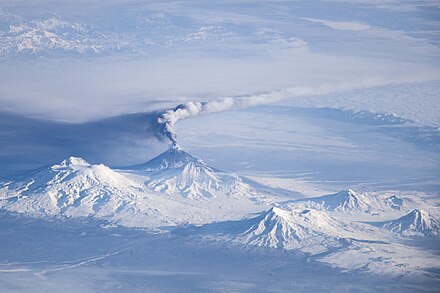
- The Pacific Plate is subducted beneath the Okhotsk plate just miles off Kamchatka's coast, and the peninsula is___extremely___geologically active. Two of the most powerful earthquakes ever recorded shook the peninsula in 1737 and in 1952 at 9.3 and 9.0 magnitude respectively. The latter caused a tsunami which ravaged Hawaii and even reached as far as New Zealand and Chile. In addition to these two mega-quakes, powerful earthquakes occur quite often. A 6.0 magnitude earthquake occurs roughly every 3–5 years with a 7.0 quake occurring roughly every 10–15 years.
- Usual precautions while on mountains, including bringing warm clothes such as wind-breaking vests and hats as the weather changes often and temperatures can fall to 0 °C (32 °F). Bring sunglasses and sunscreen due to the lack of shelter from the sun on mountains.
- Beware of bears, who have happened to ramble into the city suburbs, not to mention the remote wilderness. Do not leave food, even small pieces and cans, in the paths or on campsites. Bears have acute senses of smell and once they have tried human food they will return to the source repeatedly. Making noise and talking is advisable while trekking as bears will shun unusual and most loud sounds.
- Cold weather, though not as bad as in mainland Russia.
- Poisonous plants are rare but they do exist. Learn what they look like so you can avoid them.
Go next
It may be possible to hitch a ride on a boat heading from Petropavlovsk-Kamchatsky to Severo-Kurilsk in the Kuril Islands.
Related Wikipedia article: Kamchatka Peninsula